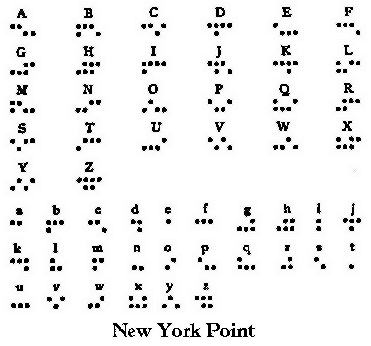New York Point
|
|
New York Point is a system of writing for the blind invented by William Bell Wait (1839-1916), a teacher in the New York Institute for the Education of the Blind. The system used three bases of equidistant points arranged in two lines (thus—: :: :::), and assigned the most common letters to the configurations with the fewest points. It competed with the American Braille system, which employed the Braille base (:::) and New York Point's principle of assigning common letters to characters with the fewest points.
Wait also invented the Kleidograph, a typewriter with twelve keys, for embossing the New York Point system on paper, and the Stereograph, for creating metal plates to be used in printing books for the blind.
Wait advocated the New York System as more logical than either the American Braille or the British Braille systems, and the two systems competed in what was known as the War of the Dots. Around 1916, writing was standardized to a system more closely corresponding to British Braille, chiefly because of the large amount of written material available in that system.
See also: Blindness education
External Links
- An autobiography of William Bell Wait (http://www.nyise.org/text/wait.htm) and discussion of the invention of New York Point.
- Robert B. Irwin's As I Saw It (http://www.nyise.org/blind/irwin2.htm), 1955, gives a history of the "War of the Dots" that ultimately led to the adoption of the English form of the braille literary code in the United States.

